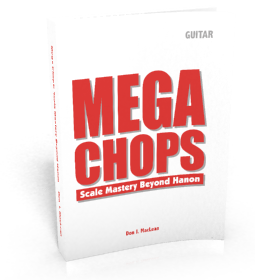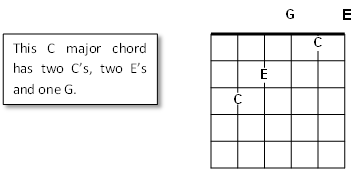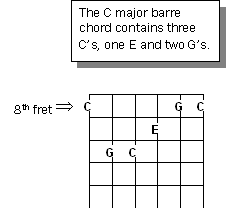Are All Notes Really Created Equal?
If you’ve done any experimentation with creating your own guitar solos, you may have started to think that all notes are not created equal.
When you improvise a melody over a chord progression, certain notes will seem to sound better than others. In fact, some notes that should work will sometimes sound outright wrong.
So What Gives?
When you play a note against a chord, one of two things will happen.
- If the note is part of the chord it will blend in.
- If the note is not part of the chord, it will create some tension or dissonance. Depending on the relationship between the note and the chord, the amount of tension can vary from mild to strong.
How this Works
Let’s take a closer look at how this works.
To build a major chord, simply play the first, third and fifth notes from the major scale.
The C major scale consists of the notes:
C-D-E-F-G-A-B-C
Each note or degree of the scale is given a number depending on its position within the scale. So the C major scale would be numbered as follows:
C – D – E – F – G – A – B – C
1 – 2 – 3 – 4 – 5 – 6 – 7 – 1(8)
The eighth scale degree is the same as the first—it’s just one octave higher.
For a major chord, take the notes 1-3-5 from the major scale. This means we are looking at the notes C-E-G. If you were to play these notes in any combination of the fretboard, you will have a C major chord. If any note other than the C is lowest pitched note, you will have what is called an inversion.
Now it’s solo time. Let’s say you are creating a guitar solo over top of the C major chord. Let’s also say that your solo uses only three notes: C-E-G on top of the C major chord.
What will it sound like? Well for starters, you will hear a very high degree of blend. Why? The notes that are being used are exclusively chord tones. Since you are only playing notes that are already part of the chord, there will be a high degree of blend and consequently, you’ll have a very safe sounding solo. In other words, it will get boring fast! Since you are only playing notes in the chord, you haven’t really gone anywhere.
To add more interest, you will want to add some other notes. This means that you are going to add notes that are still part of the C major scale—they just won’t be chord tones. The result will be a more adventurous solo. The non-chord tones you use; how many non-chord tones you use; and how you phrase and rhythmically place them, will determine the overall sound of your solo.
Tension and Release
When you listen to a good guitar solo, you will hear phrases and individual notes that combine to create tension and release.
In terms of the big picture, that’s all a guitar solo is: a deliberate manipulation of tension and release. Some guitar solos have lots of tension in them, while others have relatively little. Some styles of music have higher degrees of tension than others.
Now back to your solo…
So now, instead of just playing ideas involving the notes C-E-G, you now add in the remaining notes from the C major scale: D-F-A-B.
To get more out of this article, it’s important that you put it to use. So I would recommend you record yourself strumming a C major chord. Give yourself ample time, like a couple of minutes, or so. And no, you don’t need an elaborate guitar studio to start doing this. Most cell phones will allow you to record. Yes, the sound quality won’t be great, but it will do for now. Next, play back your recording and then play each note from the C major scale against the C major chord. Really listen to the sound of each note. Sustain each note for an extended period of time.
Once you’ve heard each note against the C major chord, begin to come up with some short 2-4 note ideas (motives) that use the C major scale.
Start each motive on a chord tone.
Then, start each motive with a non-chord tone.
Next, mix up the motives so that some start with a chord tone and others begin with non-chord tones. Which do you prefer? You will probably start off by preferring the motives that start on chord tones. As you advance as a player, you will find it easier to control more dissonant lines and you’ll probably start to love to work with more dissonant sounding lines. For now go with what you like.
The Next Step
It’s rare that you will need to solo over just one chord. So let’s add two more chords into the picture: F major and G major. This will give us what’s called a I-IV-V (pronounced one, four, five) chord progression. Chord progressions are often symbolized with Roman Numerals. This allows for easy transposition (changing the progression into other keys) and other theoretical concepts we won’t explore in this short article.
So what we now have is:
C major (I)
F major (IV)
G major (V)
The F major chord consists of the notes F-A-C. The G major chord consists of the notes G-B-D.
Now repeat the same steps we used with the C major chord, but now with the F and G major chords.
Some very interesting things will happen. If you were to play the note C over the entire chord progression, you will notice that it has a high degree of blend when it’s played against the C and F chords. But wow, what a change when you play that C against the G chord! The C is the root of the C major chord (C-E-G) and it is the fifth of the F chord (F-A-C). It is not a chord tone in the G major chord (G-B-D), so it creates a dissonant sound when played and sustained against the G chord.
Amazing?
Now, isn’t that amazing? You are in the key of C major. You are playing one of the strongest tonal chord progressions that clearly establishes the key of C major and yet, the note C, in most contexts, will actually sound like a wrong note when played and sustained over a G major chord.
Now you can see why understanding a bit of theory will give you way more control over your guitar solos and allow you to create better sounding solos off the cuff. When you understand the theory behind this, you won’t have to stumble over the bad sounding notes; you’ll know what they are, and be able to consciously manipulate them to your will.
In fact, here is a general rule when improvising. When you solo over top of the V chord in a major key, the fourth of that chord is considered an avoidance note. Now you don’t have to avoid it altogether, you just need to be careful with it.
An avoidance note is a note that you don’t want to lean on. It’s best to use it as a passing tone. Use it on a weak part of the beat and resolve it to a chord tone. I know it should probably be called “a note to be careful of”, but “avoidance note” is the current technical term for it.
Another way of looking at this general rule is the tonic note of the key is an avoidance note against the V chord.
Here is another avoidance note to be aware of, but this time it’s against the C chord.
When you played the non-chord tones (D-F-A-B) against the C major chord, what did the note F sound like? Try it once more. Play the C major chord and play the note F against this note. What does it sound like? Not so good, right? The F creates a strong dissonance against the C major chord.
So against the I chord in a major key, the fourth note is considered to be an avoidance note. Again, you can use this note, but you’ll generally want to resolve the note and not hold it for a long duration.
OK, so here is what you should work on…
Improvise some short motives over the C-F-G chord progression. Start each phrase on a chord tone.
Make Your Guitar Sing
Take a minimalist approach at first. The tendency of beginning improvisers is to over-play. Make it your goal to create short singable melodies first. Treat your guitar as if it was your voice. Remember that you need to breathe. You can’t sing endless notes without breathing. So make sure you let your solos breathe. Then you can create flashier guitar solos. Remember that a boring phrase played really fast is still a boring phrase played really fast. Good strong melody lines sound good and interesting at any tempo.
Do I Really Need to Do This or Can I Just Play By Ear?
This is really a yes and no answer. You can play exclusively by ear and not know what you are doing. There are many guitar players that just play by ear and some are very good. But here’s the thing…
If you were going to build a house but only had a hammer, nails and some wood, you would still be able to build a house, but your options would be limited. Compare this to building a house and having all of the latest tools and building materials available. Obviously, the more tools you have at your disposal the more options you’ll have.
The same is true in music, the more tools you have at your disposal the more likely it is that you’ll be able to create cool guitar solos. It doesn’t guarantee it, but it will make it easier. When you learn how things work in music, it means you don’t have to reinvent the wheel. This of course means you save time. More accurately, you save tons of time.
The best approach to soloing is to use your ears combined with theory. The beauty is when you have good ears and some theory down, you actually have three options. You can: 1) use your ears, 2) use theory, or 3) use your ears and theory.
Recommended Resources
If you don’t already know them, I would highly recommend that you learn to play the major, and minor scales as well as the major and minor pentatonic scales. With those basic scales you will be able so solo over a lot of popular music. Ideally, you should learn multiple ways to play these scales. To take your playing beyond that and have even more tools, you will definitely want to learn harmonic and melodic minor scales as well as the diatonic modes. For a great way to learn these scales and how they work with chords, check out my book called –> The World of Scales: A Compendium of Scales for the Modern Guitar Player.  When you create guitar solos you are in essence connecting one motive or melodic pattern to the next. For a detailed examination of melodic patterns and how they work on guitar, check out my course called -> Mega Chops: Scale Mastery Beyond Hanon. In this course you’ll learn how to link melodic patterns up and down the fretboard and across scale fingerings. And oh yeah, and you’ll also improve your guitar technique.
When you create guitar solos you are in essence connecting one motive or melodic pattern to the next. For a detailed examination of melodic patterns and how they work on guitar, check out my course called -> Mega Chops: Scale Mastery Beyond Hanon. In this course you’ll learn how to link melodic patterns up and down the fretboard and across scale fingerings. And oh yeah, and you’ll also improve your guitar technique. For a big picture understand of how music theory works and how it applies to guitar, check out the Absolute Essentials of Music Theory for Guitar.
For a big picture understand of how music theory works and how it applies to guitar, check out the Absolute Essentials of Music Theory for Guitar.










